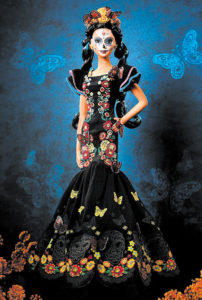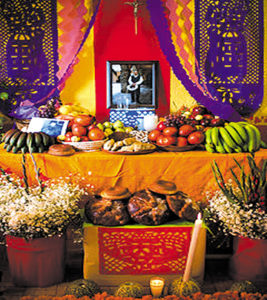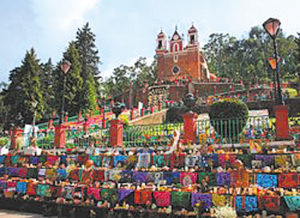 Sure, the theme is death, but the point is to demonstrate love and respect for deceased family members. Día de los Muertos, or Day of the Dead, is a celebration of life and death. While the holiday originated in Mexico, it is celebrated all over Latin America with colorful calaveras (skulls) and calacas (skeletons).
Sure, the theme is death, but the point is to demonstrate love and respect for deceased family members. Día de los Muertos, or Day of the Dead, is a celebration of life and death. While the holiday originated in Mexico, it is celebrated all over Latin America with colorful calaveras (skulls) and calacas (skeletons). Scholars trace the origins of the modern Mexican holiday to indigenous observances dating back hundreds of years and to an Aztec festival dedicated to the goddess Mictecacihuatl. It has become a national symbol and as such is taught (for educational purposes) in the nation’s schools. Many families celebrate a traditional “All Saints’ Day” associated with the Catholic Church.
Originally, the Day of the Dead as such was not celebrated in northern Mexico, where it was unknown until the 20th century because its indigenous people had different traditions. The people and the church rejected it as a day related to syncretizing pagan elements with Catholic Christianity. They held the traditional ‘All Saints’ Day’ in the same way as other Christians in the world. There was limited Mesoamerican influence in this region, and relatively few indigenous inhabitants from the regions of Southern Mexico, where the holiday was celebrated. In the early 21st century in northern Mexico, Día de Muertos is observed because the Mexican government made it a national holiday based on educational policies from the 1960s; it has introduced this holiday as a unifying national tradition based on indigenous traditions.
The multi-day holiday involves family and friends gathering to pray for and remember friends and family members who have died, and helping support their spiritual journey. In Mexican culture, death is viewed as a natural part of the human cycle. Mexicans view it not as a day of sadness but as a day of celebration because their loved ones awake and celebrate with them. In 2008, the tradition was inscribed in the Representative List of the Intangible Cultural Heritage of Humanity by UNESCO.

The holiday is sometimes called Día de los Muertos in Anglophone countries, a back-translation of its original name, Día de Muertos. It is particularly celebrated in Mexico where the day is a public holiday. Prior to Spanish colonization in the 16th century, the celebration took place at the beginning of summer. Gradually, it was associated with October 31, November 1, and November 2 to coincide with the Western Christian triduum of Allhallowtide: All Saints’ Eve, All Saints’ Day, and All Souls’ Day. Traditions connected with the holiday include building private altars called ofrendas, honoring the deceased using calaveras, aztec marigolds, and the favorite foods and beverages of the departed, and visiting graves with these as gifts. Visitors also leave possessions of the deceased at the graves.
In many U.S. communities with Mexican residents, Day of the Dead celebrations are very similar to those held in Mexico. In some of these communities, in states such as Texas, New Mexico and Arizona, the celebrations tend to be mostly traditional. The All Souls Procession has been an annual Tucson, Arizona event since 1990. The event combines elements of traditional Day of the Dead celebrations with those of pagan harvest festivals. People wearing masks carry signs honoring the dead and an urn in which people can place slips of paper with prayers on them to be burned. Likewise, Old Town San Diego, California annually hosts a traditional two-day celebration culminating in a candlelight procession to the historic El Campo Santo Cemetery.
The festival also is held annually at historic Forest Hills Cemetery in Boston’s Jamaica Plain neighborhood. Sponsored by Forest Hills Educational Trust and the folkloric performance group La Piñata, the Day of the Dead festivities celebrate the cycle of life and death. People bring offerings of flowers, photos, mementos, and food for their departed loved ones, which they place at an elaborately and colorfully decorated altar. A program of traditional music and dance also accompanies the community event.
 The Smithsonian Institution, in collaboration with the University of Texas at El Paso and Second Life, have created a Smithsonian Latino Virtual Museum and accompanying multimedia e-book: Día de los Muertos: Day of the Dead. The project’s website contains some of the text and images which explain the origins of some of the customary core practices related to the Day of the Dead, such as the background beliefs and the offrenda (the special altar commemorating one’s deceased loved one). The Made For iTunes multimedia e-book version provides additional content, such as further details; additional photo galleries; pop-up profiles of influential Latino artists and cultural figures over the decades; and video clips of interviews with artists who make Día de Muertos-themed artwork, explanations and performances of Aztec and other traditional dances, an animation short that explains the customs to children with virtual poetry readings in English and Spanish.
The Smithsonian Institution, in collaboration with the University of Texas at El Paso and Second Life, have created a Smithsonian Latino Virtual Museum and accompanying multimedia e-book: Día de los Muertos: Day of the Dead. The project’s website contains some of the text and images which explain the origins of some of the customary core practices related to the Day of the Dead, such as the background beliefs and the offrenda (the special altar commemorating one’s deceased loved one). The Made For iTunes multimedia e-book version provides additional content, such as further details; additional photo galleries; pop-up profiles of influential Latino artists and cultural figures over the decades; and video clips of interviews with artists who make Día de Muertos-themed artwork, explanations and performances of Aztec and other traditional dances, an animation short that explains the customs to children with virtual poetry readings in English and Spanish.














Follow Us